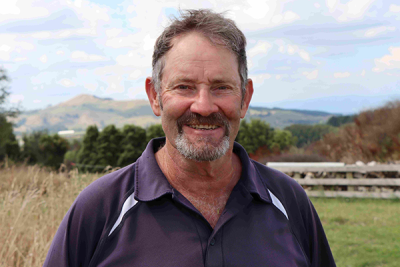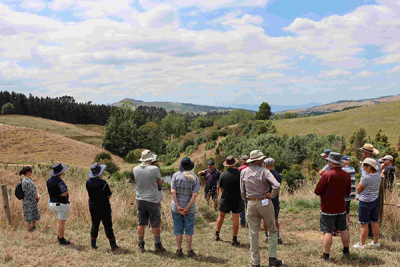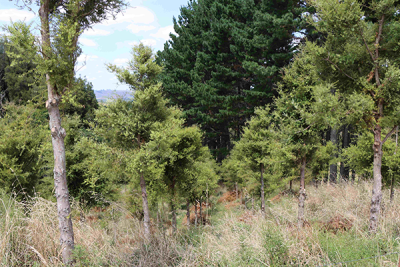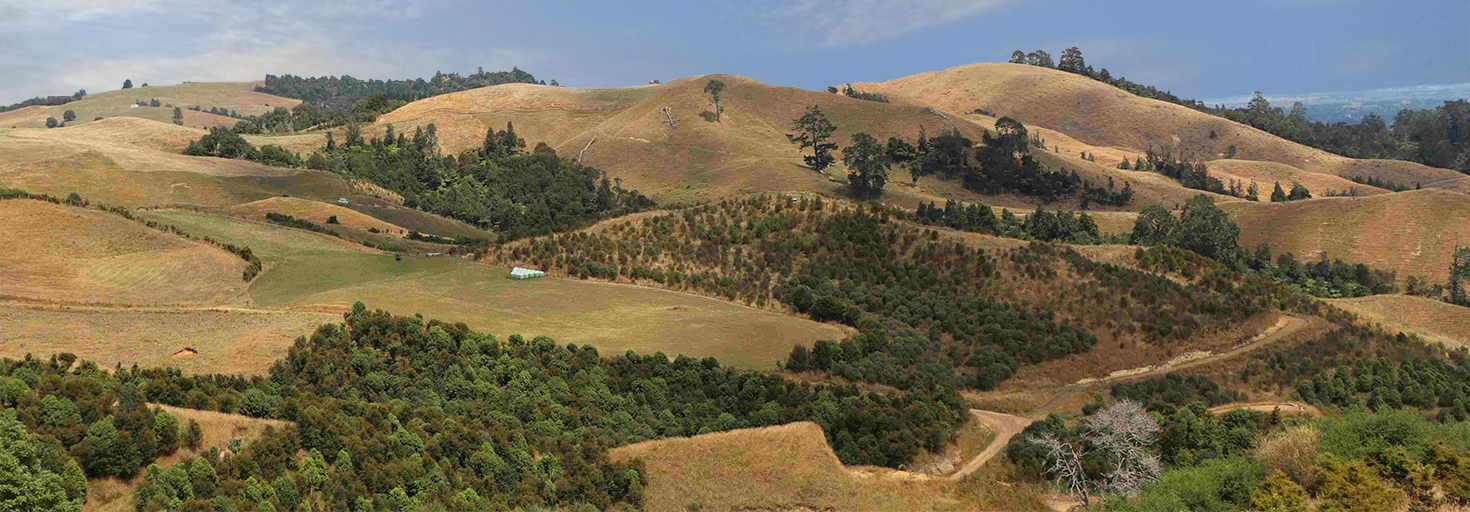
Ian Brennan says the gullies on his property weren’t suited for grazing so he planted a native forest.
When Ian Brennan started farming his hill country property in Te Miro, he feared one of his cattle would fall and break a leg in one of his paddocks.
But it was Ian himself who did.
“There is a rocky waterfall hidden in the scrub at the bottom of that gully and I always counted the cattle as they exited that paddock because I was paranoid one of them would fall and break a leg there,” says Ian, who gave up a career in IT to become a farmer when he and his wife, Trisha, bought the property in 2005.
“It was a hot summer day, and I was looking across the gully for a lost heifer – who it turned out wasn’t lost, I’d simply miscounted – when I slid downhill over a bluff. It took me 40 minutes to hop back out of the gully to my quad.”

Ian Brennan gives the Karāpiro Catchment Group a tour of his plantings on his farm.
Ian has since retired 38 hectares of steep country by planting 90,000 native plants, including timber species for a continuous cover forestry regime. With another 16 hectares protected by QEII, only 27 hectares of his property remains in paddocks and tracks to access the woodlots.
I knew long before I broke my leg that I wanted to plant all of those gullies back into native forest – the land just wasn’t suited to grazing – but I just didn’t yet have a clue how I would find the money to do it,” says Ian, who’d already made a start.
And that’s where Waikato Regional Council stepped in.
The council collects a targeted rate for river and catchment management activities to, among other things, improve water quality, reduce erosion and support biodiversity values.

Ian form prunes the trees by hand himself, removing duplicate leaders to produce a single, straight log.
Protecting steep headwaters is a very effective way of achieving these goals, and seven streams start on Ian’s property: six which feed into the Waikato River and one into the Piako River.
Together with the Waikato River Authority, the council supported Ian’s vision to retire his steep land by collectively funding 62 per cent of the cost of his fencing and planting activities. Ian was even able to contribute some of his share as work in kind, for example, as labour for the fencing and planting.
“Getting funding through Waikato Regional Council over the years made large-scale planting possible,” says Ian, who also contributed financially to the works and had a covenant created on his property title for his retired land as part of an Environmental Protection Agreement with the council.

Ian doesn’t care he won’t be around to see the mature forests, “to be the starter of things, I’m perfectly happy with that”.
The covenant allows the future harvest of his native trees, as long as he maintains canopy cover and replaces harvested trees with other native species, including for timber, or leaves the land to regenerate naturally.
“It protects the forest in perpetuity but allows the harvest of trees,” says Ian. “I hate the idea of land not being used for anything and I thought it would be cool to have just natives on the farm.”
For timber, he has planted predominently tōtara, about 15,000, but also rimu, kauri, kahikatea, puriri, tanekaha, matai, rewarewa and taraire. For nursery species, between the trees, he’s planted mostly manuka and kanuka.
“We planted primarily for catchment protection, but our point of difference is that we planted all the main native timber species and manage them silviculturally to create a high-quality timber resource for future generations.”
Ian form prunes the trees by hand himself, removing duplicate leaders to produce a single, straight log, and is currently in the process of registering for carbon credits.
“Putting the forest back in, it means that we’re going to have clean water, erosion control and habitat for all kinds of species. It’ll also help with climate.
“I don’t care I won’t be around to see the finish of it. To be the starter of things, I’m perfectly happy with that.
“I feel enormous satisfaction from finally seeing it planted! It was a bit of an Ed Hillary moment – finally knocking the bastard off!”

